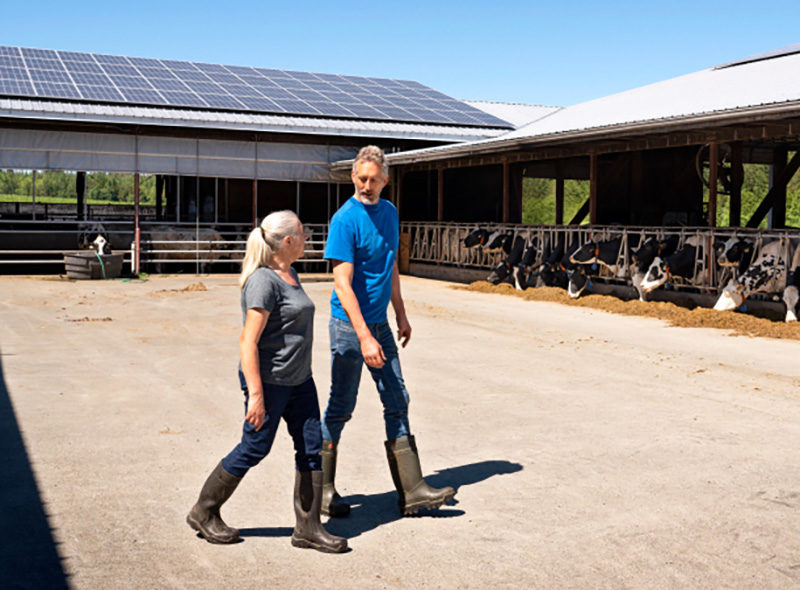From milking systems to milk cooling to water heating to ventilation and more, it’s clear that energy is a major factor in the overall cost of running a dairy farm.
Dairy producers, meanwhile, are setting bold goals for sustainability. Dairy Farmers of Canada is targeting net zero greenhouse gas emissions by the year 2050.
Indeed, cost and sustainability were the key goals when dairy producers Chris and Henrietta Groenendijk first had the idea to look at solar power for their barns a few years back.
The Groenendijks, second-generation B.C. dairy producers, operate Greendike Farm near Chemainus, B.C., in the southern part of Vancouver Island.
On trips back to Europe to visit their family, Chris and Henrietta had noticed how more and more solar panels were in use among farms there. They started investigating solar for Greendike Farms.
Would solar provide the volume and consistency of energy the farm required? After all, with 160 to 170 cows to milk and care for, energy downtime isn’t in the plan.
“Of course, the long sunny days of summer are the most productive,” says Chris, “but even on a dark short winter day, there is still solar production. The only time there is no energy produced is when there is snow or ice covering the panels. Fortunately, on southern Vancouver Island, this does not happen often.”
Working with a local electrician, the couple decided to install solar on their two barns. By sharing power back into the grid, they could knock their monthly power bill down to zero — and pay off their solar investment within 8½ years.
“BC Hydro has a net metering program where you bank energy credit in the summer to offset the rest of the year,” explains Chris. “This will ideally give you a net zero hydroelectric bill on a yearly basis.”
Powering their ideas with RBC
Choosing which solar setup to install took some time. They assessed the features, capacity and cost of different alternatives and their suitability to the farm’s needs. Who to partner with on the financing? That part was easy.
“RBC has been our financial institution since our family began farming 35 years ago,” says Chris, "and we have built a good working relationship over that time.”
A productive farmer-banker relationship pays particular dividends at times like this – when a significant capital decision is being made. Knowing the experience of other dairy producers investing in solar, RBC offered a perspective that helped advance the Groenendijks’ solar energy plans.
Notably, while the solar energy equipment would have a multidecade operating life, the financing to purchase and install it could be amortized over just 8½ years.
With RBC financing in place, the installation of Greendike Farm’s solar system began and was completed by July 2021. In fact, they have two systems. One is a single-phase system with 93 430-watt solar panels. The second is a three-phase system with 332 430-watt panels.
Cost and sustainability goals: Check
As soon as the system went live, the energy and cost savings began. In the Groenendijks’ vision, this progress will help the next generation.
“The goal of the energy savings is to make us more efficient and sustainable as we plan to transition the farm to the next generation,” says Chris. “The system has a projected lifespan of 20-plus years as it has no moving parts. There are also no batteries, as BC Hydro acts as our battery.”
As the Groenendijks approach two years of being powered by solar energy, they believe the project is meeting the goals they had originally set for it. Greendike Farm’s electricity bill, once a significant factor in the farm’s overall cost complex, has been completely offset. They are fully contributing to the "net zero by 2050" sustainability goal stated by Dairy Farmers of Canada and have set a practical example that can educate and inspire their fellow producers.
The Groenendijks’ solar system has decades of productive life still ahead, while the financing required to buy and install it should be paid off by early 2030. Essentially, then, Greendike Farm should run on more or less free electricity for the following 12 and 22 years. What’s more, as the elements of their milking system are upgraded over time, newer components will presumably have greater energy efficiency built in.
With permanently lower operating costs secured, these gains will give the Groenendijks and the family’s next generation a competitive edge long into the future.
While the Groenendijks were happy with the performance of their electrician/installer, Chris urges any dairy producers thinking about solar to do their homework and choose a reputable supplier.
His only regret? Says Chris: “I wish we had done it sooner.”









